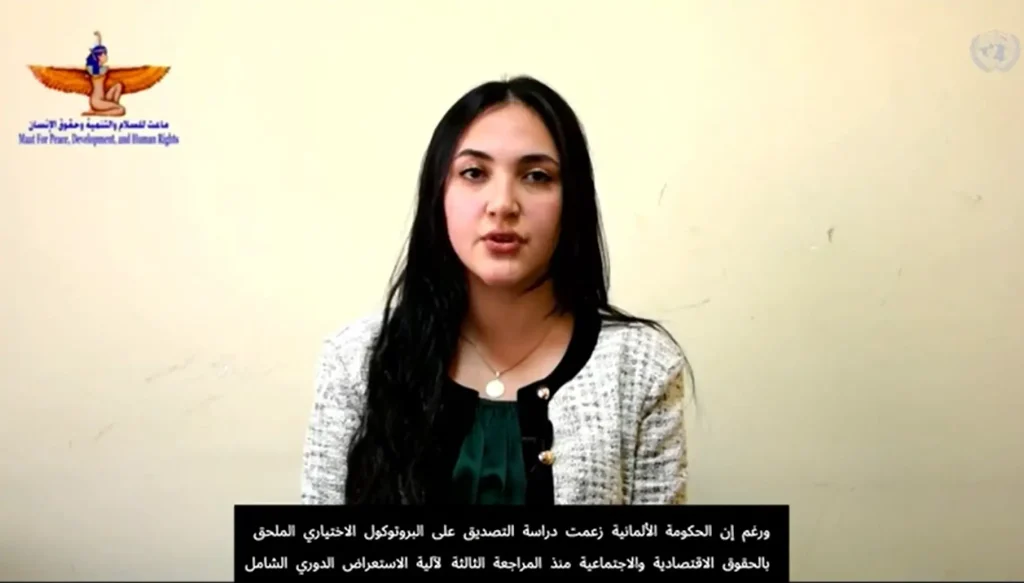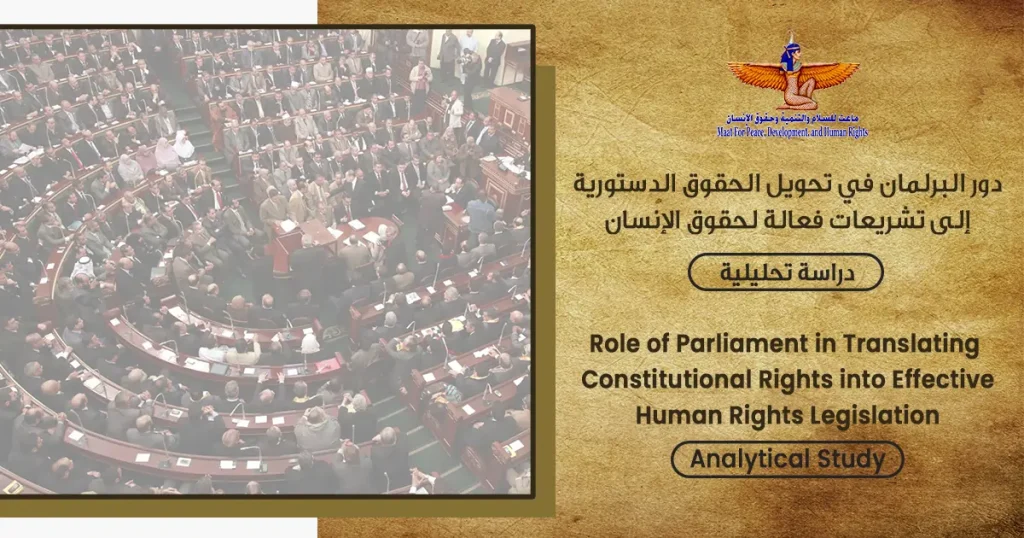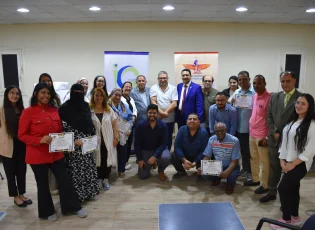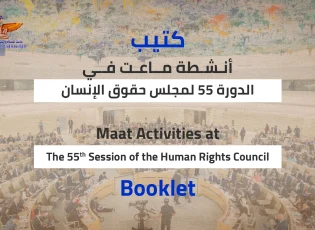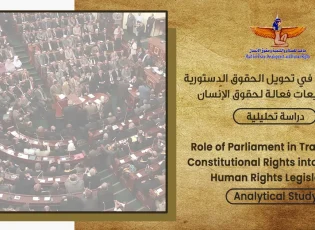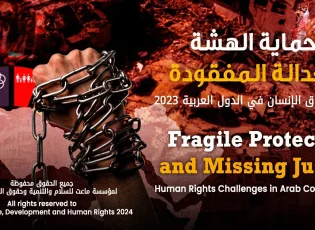Towards Improving Legislations for Building Places of Worship: Proposed Principles for the Law on Building and Restoring Churches
Policy Paper
Issued it
Public Policy Analysis and Human Rights Unit
Affiliate Foundation
, Maat for Peace, Development, and Human Rights
Under a project
The Universal Periodic Review as a Tool to Improve Public Policies during the Transition
August 17, 2016
“This release was implemented with the help of the European Union. The content of this publication is the responsibility of the Maat Foundation for Peace, Development and Human Rights and can in no way be considered a reflection of the vision of the European Union.
- Introduction:
The absence of a law regulating the construction, demolition, or restoration of new churches is one of the most important problems facing the Egyptian community as a whole and the Christian community in particular, which is what pushed Christian denominations to build churches without a license, as the available information says that a percentage of Egyptian churches does not exceed 25% Only those that have been issued licenses to build by Republican decisions, and despite the cancellation of some historical laws, such as the Hamoni Line Law and the Ten Terms of El-Ezaby, the authorities entrusted with issuing permits are still dealing with this matter in accordance with these terms and outdated legislative frameworks.
The crisis has pushed Christians, especially in the countryside, to convert their homes to small churches or to pray in the street, which led to the emergence of sectarian violence incidents from time to time, especially in the south of the country where many Egyptians live.
And under interesting Public Policy Analysis and Human Rights Unit With the Maat Foundation for Peace, Development and Human Rights with the recommendations that were submitted to Egypt in light of the universal periodic review and the Egyptian government's position on the recommendations and in light of the foundation’s implementation of a project The Universal Periodic Review as a Tool to Improve Public Policies during the TransitionFunded by the European Union during 2016-2017, the Foundation has focused on shedding light on this issue through a policy analysis paper entitled” Towards improving legislation for building places of worship - the law on building and repairing churches–“ Let's stand on the legal, constitutional and human rights situation for this issue.
The paper dealt with several basic points: It started with a historical background on the crisis, then the paper moved to present the constitutional, legislative and legal framework for that issue, then the paper moved to presenting the statistical reality of the number of churches of the different denominations according to the available statements of those responsible for them. This was followed by a presentation of the problem and obstacles of building churches and in the part The last of them, this paper listed the most important solutions and recommendations to address the issue of building churches at the legislative level. The paper presented an example of the most important principles that should be contained in the legislation that will regulate the building of churches.
- Historical background to the problem
The owners of non-Islamic religions in Egypt suffered a lot before the issuance of the Hamayouni Calligraphy Law, especially at the level of religious affairs, and there was no law regulating except for the authority of the governor during that period until the year 1856 of the Hamayuni Calligraphy Law was issued, which was issued by Sultan Abdul Majid I with the aim of organizing the building of a role. Worship in all the provinces of the Ottoman Empire, applied to all non-Muslim religions and religions.
Also, during the reign of Muhammad Ali Pasha, the founder of modern Egypt from the period 1805 to 1849, all Ottoman rulings against the Christians of Egypt were canceled. They were even allowed to build new churches, and they were also allowed to carry arms and join the army of Egypt and appoint them in the army, but rather directors to high positions, the most direct of which was direct. The equivalent of the finance minister now.
During the reign of Said Pasha from 1854 to 1863, he added some important decisions to Muhammad Ali’s decisions, including the abolition of the jizya in December 1855. In general, the Hamayuni Calligraphy Law is very good, except for its third article, which states that “Only the Sultan personally has the right to authorize building churches. And restoring them, as well as cemeteries for non-Muslims, ”which directly impeded the construction of churches, and the work of that decree continued until 1933 AD, when El-Ezaby Pasha, the Minister of Interior at the time, set 10 conditions impeding the construction of churches, in place of the aforementioned Hamayouni calligraphy article. And the law remained constant, until Jamal Al-Atifi, the former representative of the People's Assembly, prepared in 1972 a report containing a remedy for the recurrent crises of church building, following the Khanka sectarian incident, during the era of the late President Anwar Sadat, and that report came out with several recommendations, the most important of which is amending laws Building Christian places of worship and abolishing the incapacitating provisions contained in it, but this project remained locked into inclusion until it was completely lost.
The crisis continued during the era of former President Muhammad Hosni Mubarak because state agencies did not seek to find a legal solution, and problems accumulated in building and repairing churches in all governorates, forcing many parishes to build unlicensed churches, or to establish Christian rituals, in the service buildings of churches, and In some plots of empty land belonging to a Christian citizen, sometimes secretly due to the intransigence of the state apparatus, and the situation remained throughout the 30 years of the rule of former President Mubarak until he stepped down from power after the January 25 revolution in 2011 and the military council took over the management of the country’s affairs. The state of political liquidity as a result of the outbreak of the revolution, strenuous efforts appeared to issue a unified law for places of worship, but the law found strong and severe opposition, due to the fundamental differences between the mosque and the church in the internal components, the required space and the necessary population density, which prompted the political leadership at that time to stop talking about this matter Until the 2014 constitution came, which stipulated in the articles of the transitional provisions obligating the House of Representatives to legislate the law on building and restoring churches in its first session.
- Constitutional and human rights frameworks.
- First: the constitution
The Egyptian constitution stated in Article 64 that “Freedom of belief is absolute. The freedom to practice religious rituals and establish places of worship for people of heavenly religions is a right regulated by law.
Article 235 also stipulated that “the House of Representatives, in its first session after the implementation of this constitution, shall issue a law to regulate the construction and restoration of churches, in a manner that guarantees the freedom of Christians to practice their religious rites.”
- Second: charters, treaties and voluntary commitments
The text on freedom of belief and the practice of worship has been contained in many international charters and covenants, including:
- First: The International Covenant on Civil and Political Rights:
Article 18 states that “Everyone has the right to freedom of thought, conscience and religion. This includes his freedom to owe a religion, his freedom to embrace any religion or belief he chooses, and his freedom to demonstrate his religion or belief in worship, rituals, practice and education alone or with his intercourse, and in front of the public or alone.
Article Twenty-Seven stipulates that “In countries where there are ethnic or religious linguistic minorities, persons belonging to the aforementioned minorities shall not be deprived of the right to enjoy their own culture, to profess their religion and to practice its rituals or to use their language, in association with other members of their group.
- Second: The Universal Declaration of Human Rights
Article 18 stipulates that “every person has the right to freedom of thought, conscience and religion, and this right includes his freedom to change his religion or belief, and his freedom to manifest his religion or belief in worship, rituals, practice and education, alone or with a group, and in front of the public or alone.”
- Third: The Arab Charter for Human Rights
Article Twenty-Seven stipulates that “Individuals of every religion have the right to practice their religious rites, and they also have the right to express their ideas through worship, practice, or education without prejudice to the rights of others. No restrictions may be imposed on the exercise of freedom of belief, thought and opinion except as stipulated Law.
- Fourth: The African Charter on Human Rights
Article 8 stipulates that freedom of belief and the practice of religious rites is guaranteed, and no one may be subjected to measures restricting the exercise of these freedoms, subject to the observance of law and public order.
- Third: voluntary pledges
The Egyptian government fully agreed before the Human Rights Council in Geneva, while undergoing the universal periodic review, to accept Recommendation No. 166-199, which states “Strengthening the protection of the rights of religious minorities, in particular creating the necessary conditions for the exercise of freedom of worship, and putting an end to impunity for violations of these rights.” And provided by the state (Cabo Verde).
- Legal frameworks for building churches
Places of worship in general, and churches in particular, are subject to several laws that must be taken into account when requesting construction
- The HAM line
- In February 1856 AD, Sultan Abdul Majid I issued the High Decree for reforms, which is known as the Hamayouni Line, and the Royal Decree includes general principles and regulations for the affairs of non-Islamic sects, and the Hamayuni line includes the approval of all the rights stipulated in previous laws for Christians, the most important of which are: the formation of councils for the sects to manage the local interests Concerning their internal affairs, and for the Patriarch to submit requests to build churches to the Sublime Porte, and to issue the necessary permits for their construction.
- Conditions for building churches
- In February 1934, Al-Ezaby Pasha, Undersecretary of the Ministry of the Interior, issued ten conditions for permission to build churches, which required the fulfillment of the following data: Ownership documents for the land and its condition “cultivation or space” The extent of the distance of the church from the mosques and shrines in the sub-district, the presence of the land in the Christian or Muslim area, is there The aforementioned sect has another church in this town, the number of members of the sect present in this town, if it appears that the place to be built on it is close to the bridges of the Nile, canals and public utilities, the opinion of the competent authority is taken in this, and an official record of these investigations is made and sent to the Ministry, it is necessary The applicant must present with his application a practical fee to be signed by the religious chief and the engineer in charge, and the body responsible for the investigations must verify its validity.
- Decisions of the President of the Republic
- Republican Resolution No. 13 of 1998 authorizing governors to issue decisions regarding the restoration of churches and their annexes that are currently in place.
- Republican Decree No. 453 of 1999, which granted the administrative authority in charge of planning affairs in each governorate, a license to restore the existing places of worship.
- Presidential Decree of the Arab Republic of Egypt No. 291 of 2005, which stipulated:
- Article 1: “The governors - each within their jurisdiction - authorize the Christian religious sects to demolish a church, to establish a church in its place on the same site, and to erect a building or make modifications or expansions in an existing church, and the license application must be decided upon - after consulting the relevant authorities. - Within thirty days from the date of its submission accompanied by the necessary documents, and the application may not be rejected without a reasoned decision.
- The second article stipulates that “the restoration or strengthening of existing church facilities shall be based on written notification from church officials to the administrative authority in charge of planning affairs in each governorate.”
- The Local Administration System Law promulgated No. 43 of 1979, especially the following articles
- Article 28, which stipulates that “the governor may, after the approval of the local people's council of the governorate, and within the limits of the general rules established by the Council of Ministers - decide the rules for disposing of the land prepared for construction owned by the state and the local administration units in the governorate ... “
- Antiquities Protection Law issued No. 117 of 1983, especially articles
- Article 1, which stipulates that “is considered the antiquity of every real estate or movable produced by different civilizations or brought about by the arts, sciences, literature and religions from prehistoric times and through successive historical eras until a hundred years ago until it had an archaeological or historical value or importance as a manifestation of different civilizations Which was established on the land of Egypt or had a historical connection to it ... .
- Article 13, which states: “The registration of the real estate property and the notification of the owner thereof in accordance with the provisions of the previous article shall entail the following provisions:
- It is not permissible to demolish the whole property or remove part of it from the Arab Republic of Egypt.
- Inadmissibility of expropriation of land or real estate. As for the lands adjacent to it, its ownership may be expropriated after the approval of the minister in charge of cultural affairs based on the proposal of the Authority’s Board of Directors.
- It is not permissible to renew the property or change its features in any way except with a license from the Chairman of the Authority after the approval of the competent permanent committee, and the conduct of the licensed works is under the direct supervision of the commission’s representative.
- Article 15, which stipulates that “any existing exploitation by individuals or bodies of an archaeological site, land or building of historical value shall not result in any right to possess it by prescription, and the authority shall, whenever it deems it necessary, vacate it in exchange for a fair compensation.”
- State Private Property Law No. 7 of 1991, especially articles
- Article 5, which stipulates that “it is prohibited to use the lands subject to the provisions of this law for purposes other than those for which they are designated. However, by a decision of the President of the Republic after the approval of the Council of Ministers based on the proposal of the competent minister - as the case may be - re-allocate it to any other party or for any other purpose. . In the event of a dispute between ministries, public authorities and local administration units or between these authorities and each other about determining the competent authority to manage, exploit and dispose of any lands or real estate from the aforementioned, the matter shall be submitted to the Council of Ministers, and its decision in this regard shall be binding on all, and this ruling shall apply to the existing disputes. Between the aforementioned bodies when this law comes into force
- Law regulating the demolition of buildings and structures that are not likely to fall and preserving the architectural heritage issued under No. 144 of 2006.
- The second article of the law stipulates: “It is forbidden to permit the demolition or addition of buildings and structures of a distinct architectural style associated with national history or with a historical figure or that represent a historical period or that are considered a tourist destination, without prejudice to what is legally entitled to compensation. It is not permissible to demolish anything other than that, or to initiate their demolition except with a permit issued in accordance with the provisions of this law. The Prime Minister issues a decision on the standards and specifications of buildings and facilities referred to in the first paragraph, based on the proposal of the minister concerned with cultural affairs, in agreement with the relevant ministers and after the approval of the cabinet. A decision is issued by the Prime Minister to determine these buildings and facilities… ”.
- Building Law issued under No. 119 of 2008
- The current statistical reality.
The number of churches in Egypt is the most difficult and controversial number for many years. The state does not provide any official statistics on the number of churches in Egypt as data based on sectarian dimensions, which is inconsistent with the state’s policy according to government officials, but Egyptian Christians look to the announcement. The number of their churches as a clear indication of the tolerance or arbitrariness of the state in dealing with the issue of building new churches.
However, the Egyptian Church has an accurate inventory of its affiliated churches, but it always hesitates to disclose it for fear of government reactions, totally rejecting any official census or even issued by the Church. Al-Badeel newspaper published in one of its preparation in the year 2012 figures that it said it obtained from one of the books distributed inside the church entitled “Directory of Churches” and monitors a set of data on the number of Orthodox churches in Egypt. Data contained in the guide confirm that the number of Orthodox churches reached one thousand and 326 churches. While the Protestant Church revealed that the number of its churches reached 1100, while the number of Catholic churches reached 200, which means that the total number of churches in Egypt reached 2,626. The census confirmed that the Orthodox Church has 405 churches in Lower Egypt and 796 churches in Upper Egypt. The governorate of Cairo came in first place among the governorates of the Republic, while Giza came in second place, while the Governorate of Alexandria came in the eighth place, while the governorates of North Sinai and South Sinai came in last place as they are the fewest governorates that include Orthodox churches, with a total of more than 1200 churches. Republic level. ([1])
What confirms the above is the statements of Pope Tawadros II, the pastor of the Orthodox Church and Patriarch of the See of St. Mark, who confirmed that the number of Christians in Egypt exceeds 15 million citizens and that the Orthodox Church owns more than 1000 churches in addition to more than 50 monasteries in various parts of the Republic.
And at the end of last year, Father Andre Zaki stated that the number of recognized evangelical churches is more than 1100 recognized and licensed churches. ([2]) According to the statements of the Evangelical Church.
Also, Patriarch Ibrahim Ishaq, the Coptic Catholic Patriarch in Egypt, stated that the number of Catholic churches is 200, of which in the governorates of Cairo and Giza 50 churches, Assiut 35 churches, Minya 30 churches, Sohag 20 churches and Luxor and Aswan 10 churches([3]). He also added that the number of Catholic Christians reaches 250,000 Egyptian citizens belonging to 7 large dioceses concentrated in Cairo, and that the Church sponsors more than 122 schools for Catholic nuns.([4]) .
In a study conducted by lawyer Hossam Abu Eissa, he explained that according to the statistics of the Central Agency for Mobilization and Statistics, the total number of churches reaches 3126, in addition to dozens of monasteries spread throughout the Egyptian governorates ([5]).
- The most important problems and obstacles to building churches in Egypt.
The problem with building churches lies in the fact that despite Resolution No. 291 of 2005 authorizing the governor to approve building churches, in reality it is still not adopted except by a presidential decision after the matter was presented to the Ministry of Interior and a report was submitted, as a result that the decision stipulated a sentence after reviewing the relevant bodies. He is a very loose reformer. This is considered as a continuation of the provisions of the Hamayouni line, and the Egyptian state continued to follow this decision, and the licenses of churches became by order of a republican decree, despite the approval of the State Council in more than one ruling and fatwa stopping its validity and the necessity of issuing a license for churches from the head of state until an alternative legislation is issued for this line, the most famous of which It is the historical ruling in Case No. 615 of the Judicial Year 5, dated December 16, 1952, issued by Judge Abd al-Raziq Pasha al-Sanhuri, Chairman of the State Council, in which he stated, “The requirement for a license to establish places of worship in the manner that is stated in the Hamayouni line may not be used as an excuse. To erect unjustified obstacles without establishing these homes that are inconsistent with the freedom to hold religious rites.
The failure to implement the provisions of the State Council and the failure of successive regimes and parliamentary councils to issue a law regulating the construction of churches resulted in the continuation of these legislative arrangements in place in light of the issuance of Republican decisions to authorize the building of new churches according to this method, even after the January 25 revolution and during the eras of the Military Council and the former president. Mohamed Morsi and the interim president Adly Mansour, the current president, Abdel Fattah El-Sisi, continued to issue licenses to churches according to them, the last of which was a license for a Coptic Catholic church in the new city of Assiut in December 2014.
Unfortunately, the reality governing church building legislation is the same as that governing the construction of service buildings belonging to churches or for parishes and monasteries, whether These buildings were attached to or adjacent to churches, or even if they were separated from them in separate places . Accordingly, the procedural and security guardianship imposed on building, expansion and restoration of churches is the same imposed on buildings Affiliated services, it does not matter that the service buildings are intended to provide service for educational classes, function and sponsorship halls Health care, elderly care, and other services, without holding religious rites and prayers.
In addition, Presidential Decree No. 13 of 1998 regarding delegating governors to the powers of restoration and strengthening of churches is considered a constitutional decision, which clearly violates the text of Article 53 of the Constitution, which provides for the equality of citizens regardless of origin, gender, religion or belief, as well as Article 64 which states I must have freedom of belief, as this freedom can only come with equality in the freedom to build places for practicing religious rites, to maintain them, to restore them and to support them if they are about to collapse. It is not permissible for the mere restoration of a bathroom in a church to be the subject of a decision issued by the governor, which does not happen in mosques. These decisions are for neighborhood planning departments only.
Also, the intransigence of the young employees, after the decisions to renovate churches were referred to the local administrations, which consist of multiple departments such as the engineering administration, the municipality and the governorate other than reviewing security, with the presence of red tape and bureaucracy in decision-making, and on the other hand the control of young employees instead of one being the President of the Republic who He issues one order, and there are dozens of employees and dozens of orders, which led to the disruption of the restoration and construction of churches, which leads to the disruption of the delivery of required papers as a result of some employees stalling and procrastinating on ideological backgrounds.
Security is also sometimes intransigent in handing over the land intended for ecclesiastical construction under the name of security reasons for fear of a crisis between some Muslim and Christian militants, especially in the governorates of Upper Egypt, some governorates of Lower Egypt, and some areas in the capital such as Imbaba, Shubra and Helwan regions, which is considered a disruption of the law. Examples include the issuance of Republican decisions to build some churches, which were stopped by the localities under the excuse of the security caller, such as the Church of Saint Gerges in Ras El-Bar and the Church of Liberation in Imbaba.
The construction of churches is also stopped for long periods despite obtaining the decision to establish and the availability of all the necessary conditions for that as a result of some lawyers filing lawsuits to stop the decisions issued to build the church, and accordingly the decision is stopped until the case is decided, which continues for long periods in the courts, especially in light of the high number of cases Litigation within the administrative courts.
Also, there is a major problem in the system of church building legislation, which is the clear definitions of ecclesiastical rituals and the consequent specialized buildings and environment and health requirements for the implementation of those rituals, and there is no legislation that describes ecclesiastical degrees and clarifies their sizes to differentiate between monasteries, archdioceses, dioceses, the great church and the church intended for prayer only .
- Final recommendations and principles that must be included in the law
- Powers to obtain a building permit
Unifying the authority to obtain a building permit for places of worship by establishing a unified body to build houses of worship in each governorate that is affiliated with the governor and heads them himself. It is formed every four years and its work may be extended for one time only, and its workers are assigned from all exports and bodies entrusted with obtaining permits for construction, demolition or restoration of a role All worship must be held every month to discuss the requests submitted by the legal official within that governorate, provided that the decision is made within 90 days from the date of receiving the request that fulfills the conditions.
- Legislative sanctions on those who are intransigent
- Work to develop new articles in the Penal Code that isolate, imprison or fine anyone who works to disrupt and not implement the decision to establish a church or restore it, demolish it and rebuild it to ensure the implementation of decisions and work to reduce the intransigence of some of the employees who are entrusted with obtaining the necessary permits for construction
- The application of Article 123 of the Penal Code to anyone who does not comply with the implementation of a judicial ruling that states “Shall be punished with imprisonment and dismissal every public official who uses the authority of his position to suspend the implementation of orders issued by the government or provisions of laws and regulations or delay the collection of funds and fees or suspend the implementation of a judgment or order issued From the court or from any competent authority, every public official who intentionally refrains from implementing a judgment or order of the aforementioned shall be punished with imprisonment and dismissal from any of the aforementioned after eight days have passed from his warning by a reporter if the execution of the judgment or order falls within the jurisdiction of the employee.
- Legal definitions
From the above, we see the enactment of a new law for the construction of all kinds of churches and their annexes and monasteries, provided that it contains these principles
- Definition of buildings and their accessories
- The monastery: It is a complex for the monks, provided that the monastery is in a suitable place and has a large area in which there is calm and wilderness, and has a wall and sources for irrigation and electricity, and that the place is integrated in the buildings in terms of the people, the church, the host, the retreat, the kitchen, the library, and it can be Inside a school for education, which has projects for self-sufficiency, provided that they are subject to the laws in force in the establishment of each project separately.
- The Church: It is an independent building, in which the Christian prayer and religious rites are practiced on a regular basis. It consists of one floor or recurring floors and it must have a final roof, and it may include inside all or any of the following:
- A temple or pulpit: The place where professional clergy performs religious rituals and prayers according to church rules and traditions.
- The nave: It is the place where the worshipers are to perform the prayer and religious rituals with the clergy.
- The Baptism Hall: A place used to perform the rite of baptism and is provided with facilities such as water, electricity and sanitation
- The lighthouse: A raised part of the church building in the form of a square, rectangle, octagonal shape, cylindrical shape, or other forms, that is connected to the church building or separated from it according to religious traditions or engineering design.
- The church annex: It is built for the church within the boundaries of its wall, and includes, according to need, the places necessary for the church to conduct and manage its religious services.
- The retreat house: It is a church building that includes places of residence and places for practicing spiritual, cultural and recreational activities.
- Place of making the sacrament: a place inside the church or the annex of the church equipped for making the sacrament, and it meets all health requirements, environmental and industrial safety standards, and safety standards in accordance with the laws in force. Establishing places of food industry.
- Al-Qallali: They are private rooms for monks in the monastery and may be in the form of a cave outside the monastery as well.
- Denomination: legal and natural persons
- A- Sect: It is the religious sect for which the state recognizes a legal personality
- B- The competent religious chief: He is the supreme religious head of every recognized Christian community in the Arab Republic of Egypt.
- C- The Competent Governor: The Governor in whose jurisdiction the businesses subject to the license are regulated by this law are located.
- D- The legal representative of the sect: He is a natural person who is exclusively competent to take all measures related to any of the works required to be licensed, and the supreme religious head of each sect determines him in each case.
- C- The works required to be licensed: construction, expansion, elevation, modification, consolidation, restoration, demolition, or exterior finishes of the church or the church extension.
- The law must also include setting a clear standard for the area that the church must establish, taking into account that the area and the number of its visitors from each sect are proportional, taking into account the population growth rates. The church has the right to include more than one structure, pulpit, nave, baptism hall, or lighthouse or more than A home for retreat
- The law regulates submitting the legal representative of the sect to the competent body - the Commission for Establishing Places of Worship - in the governorate, with a request to obtain a certificate that there is no objection to carrying out any of the works required to be licensed, and the administrative authority must give the applicant evidence of receipt of his application on the day of its submission. This request must be accompanied by the ownership documents and the necessary documents to indicate the nature of the required works, their location and their limits, and the authority shall respond to the request within 90 working days, and the authority may not respond to the rejection without clarifying the reasons. In the event that these reasons are removed, approval for construction is taken within 30 working days starting from today. Next to notify the authority to remove the reasons for the ban
- The legal representative of the sect may apply to the competent body - the Commission for Establishing Places of Worship - in the governorate to apply for a certificate that there is no objection to demolishing and rebuilding a church built with a license or whose status has been reconciled in accordance with the provisions of the law, provided that the demolition license is comprehensive for the building permit after the approval of the competent authority in accordance with Engineering standards needed.
- The competent authority shall decide on the submitted application within a period not exceeding 90 days from the date of its submission, and notify the applicant by a registered registered letter with acknowledgment of receipt of the results of the examination of his application. The legal representative of the denomination has the right to object to the grounds or remove them in order to obtain a license for church construction.
- The Administrative Judiciary Court alone, in all its degrees, is exclusively competent to hear cases that are brought by the legal representative in the event that the authority refuses the license and after removing the reasons for the prohibition. The same court shall also have jurisdiction in cases that are brought against the authority’s decisions regarding granting or denying licenses to stakeholders.
- It is not permissible to change the purpose of the licensed church or the extension of the licensed church to any other purpose, even if the conduct of prayer and religious rituals in it has ceased, except with the approval of the competent authority, and any conduct to the contrary shall be null and void.
- Each governor forms a committee to list churches within his governorate, provided that it includes the legal representative of each sect of the recognized, and all of them are presented to the competent authority to express an opinion on their safety and their compliance with the requirements stipulated by the law and the laws regulating construction, occupational safety, safety and health requirements for the chambers of making sacrifices.
[1] – Alexandria Church for Coptic Catholics website
[2] A statement by Andreya Zaki, head of the Evangelical community in Egypt
[3] – Al-Ahram newspaper, issue of February 22, 2014
[4] Previous source
Towards improving legislation for building houses of worship




